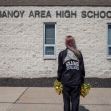Disciplining high school students for racist, bullying, vulgar, or harassing speech posted on social media does not violate the First Amendment whether it occurs on campus or in the privacy of students’ homes.
The Ninth Circuit followed a recent decision by the U.S. Supreme Court that said social media posts with “vicious invective that was targeted at specific individuals contribute nothing to the ‘marketplace of ideas’,” the free speech arena that is vigorously protected by the First Amendment. With this clear foundation established, the question before the Circuit Court was whether the students who posted the “deeply offensive and insulting words” and images about some of their African American classmates are insulated from discipline because their speech occurred off campus. They are not.
Plaintiff-appellants Kevin Chen and Cedric Epple sued Albany High School (AHS) in Alameda County and several of its administrators for violating their First Amendment rights for what they considered to be private speech. The Court’s decision, authored by Justice Daniel P. Collins with an admiring concurrence by Justice Ronald M. Gould on December 27, used the “sufficient nexus” test created by the U.S. Supreme Court in Mahoney Area School District v B.L in 2021 to rule that it was “plainly foreseeable” that the students’ posts would “ultimately hit their targets” causing “significant impacts” to both individual students and the school.
Collins’ decision also concluded that disciplining the students did not violate either the California Constitution or the State’s Education Code. The Ninth Circuit thus affirmed the decision of Justice James Donato of the United States District Court for the Northern District of California.
The appeal arose from a grant of summary judgment against the two student-plaintiffs. Four other students were initially disciplined but settled with the school district. In 2016, Epple created what he said was a private Instagram account for only 13 select friends. He used it to share “funny memes, images, and comments” that were not appropriate for his other Instagram account, which was available to a “wide audience.” Chen was one of the friends who had access to Epple’s account.
From November 2016 to March 2017, Epple created “cruelly insulting posts” about some of his classmates. They included pejorative comments about their physical appearance and contained “vicious…invective” about specific Black classmates. For example, he posted a photo of Black members and the coach of the school basketball team with nooses around their necks. He distributed posts displaying slave hangings and “made light of Ku Klux Klan violence.” Other posts called Black students “gorillas.” Chen added positive comments to Epple’s posts and made some of his own. This behavior continued for several months, even when fellow classmates criticized and disparaged the two of them.
Soon, word of the racist social media accounts spread throughout the school. One student borrowed the phone of one of Epple’s group and took pictures of what she saw. She shared the photos with ten of her friends who became “upset, yelling, or crying.” When the principal learned about the social media activity, he talked to the girls about the posts. After viewing photos of lynchings and nooses, he determined they were threats of violence and called the police. The next day, police officers interviewed Epple, Chen, one other student, and their parents. All students received five-day suspensions, and expulsions were recommended. The record contains ample evidence of the harmful effects the postings had on many of the Black students, some of whom left AHS because they were mentally and physically afraid to continue attending. Community protests and rallies were held.
Right before the expulsion hearing, Chen and three other students on the account filed a federal lawsuit against AHS. The District Court enjoined the hearing. But the expulsions of both Chen and Epple were ultimately granted. Epple appealed his expulsion to the Alameda County Board of Education. He claimed that one of the board members, who had participated in the protest demonstration, was biased against him. The state court found no bias. Then, Epple sued in federal court, claiming his due process and First Amendment rights were violated. Chen filed a similar suit along with another defendant who ultimately settled. The District Court issued summary judgments against them, and both appealed.
After recounting the facts, Justice Collins wrote that there were three parts to his opinion: the Supreme Court’s rulings on disciplining students for on-campus speech; whether those rulings can apply to off-campus speech; and whether the students’ expulsions were permitted under either the California Constitution or the California Education Code.
The Supreme Court’s decision in Mahoney Area School District v B., he explained, would show that plaintiff’s “speech bore a sufficient nexus to AHS and its students to be susceptible to regulation by the school.” They reasoned that discipline is appropriate if the speech could cause “disruption” or if it “collides with the rights of other students to be left alone.” He also said it is well settled that minors do not have the same rights as adults and added that a “school must have the authority to protect everyone on its premises.” He wrote that “Nothing in the First Amendment would even remotely require schools to tolerate such behavior or speech that occurs under its auspices.”
Turning to the arguments that discipline was forbidden because the speech was private and did not occur on campus, the Justice began by stating that “Off-campus speech is not necessarily beyond the reach of a school district’s regulatory authority.” The Mahoney decision, which held that a cheerleader could not be disciplined for using profane language in an off-campus social media post, was distinguished. He wrote that, unlike the cheerleader,” Epple’s speech bore a sufficient nexus to AHS to warrant disciplinary action by the school.” He said that Epple’s intent to “keep the account private was not controlling.”
The correct standard, he said, was “whether it was reasonably foreseeable that the speech would reach and impact the school.” His conclusion made it clear that social media is not the same as more traditional speech. He wrote, “Given the ease with which electronic communications may be copied or shown to other persons, it was plainly foreseeable that Epple’s posts would ultimately hit their targets, with resulting significant impacts to those individual students and to the school as a whole.”
That is exactly what occurred at AHS when Epple’s posts “hit their target” and caused incalculable pain to many of its African American students. The posts were “a particularly intolerable (and socially unnecessary) mode of expressing whatever idea the speaker wishes to convey.” In addition, plaintiffs’ rights were not violated by the California Constitution or Education Code.
The relationship between the First Amendment and social media is evolving. Although the Supreme Court has not yet ruled that off-campus and on-campus speech deserve parallel treatment, this case demonstrates that claims of privacy will not protect abusive, racist or harassing speech.






